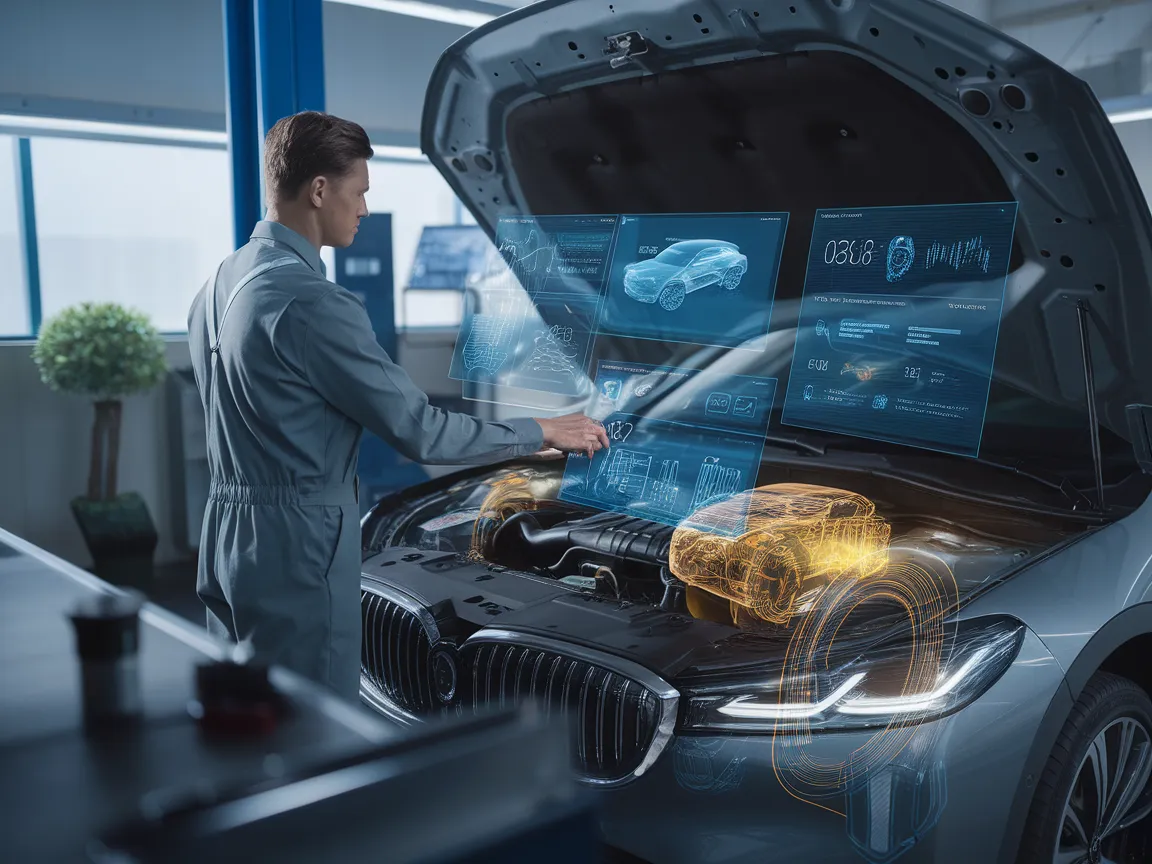In the field of vehicle servicing, diagnostic procedures require precision and expertise to accurately pinpoint car malfunctions. Initially employ diagnostic scanning tools to obtain error codes for real-time analysis. These codes help professionals identify potential issues, while adhering to a systematic Eight-Step Diagnostic Process maintains complete evaluation. Cross-reference system readings with manufacturer specifications and meticulously document all processes. Initial and final diagnostics are crucial for confirming repair accuracy and safety standards. Including Technical Service Bulletins (TSBs) streamlines repair procedures with recent factory updates. Through keeping thorough reports and transparent client updates, you'll be properly positioned for developing comprehensive troubleshooting strategies. Learn more about methods to enhance these processes.
Essential Points
- Modern diagnostics leverage electronic diagnostic equipment to identify and analyze vehicle issues through Diagnostic Trouble Codes (DTCs).
- The Eight-Step Diagnostic Process provides structured and complete automotive diagnosis and maintenance.
- Pre-scan and post-scan processes validate proper system operation and improve maintenance precision and reporting.
- Technical Service Bulletins (TSBs) offer manufacturer guidance for addressing targeted vehicle concerns.
- Regular software updates address safety considerations and improve driver assistance capabilities.
Exploring Modern Vehicle Diagnostics
Regarding grasping modern vehicle diagnostics, it's crucial to acknowledge the intricate blend of advanced technology and traditional inspection methods that characterize the process.
It's clear that the core of diagnostics lies in state-of-the-art tools like OBD-II scanners. These tools interface directly with your vehicle's onboard computer systems, providing live system analysis, component testing features, and even module programming functionality. They range from basic code readers to sophisticated equipment capable of detailed analysis.
Comprehending Diagnostic Trouble Codes (DTCs) is crucial. Each DTC reveals specific insights about your vehicle's issues. The first character indicates the affected system, such as the Powertrain or Body. The second digit reveals if the code is universal or brand-specific, while the remaining digits pinpoint the fault and subsystem.
Never overlook the importance of visual inspection, which enhances electronic diagnostics. Checking for surface defects, fluid conditions, and component wear can validate electronic findings and highlight additional issues.
This integration guarantees a comprehensive diagnostic approach, enabling you to pinpoint problems accurately and efficiently. By combining these technologies and techniques, you effectively harness the full potential of modern vehicle diagnostics to maintain ideal vehicle performance.
Advanced Diagnostic Protocols and Recommended Practices
To successfully manage the intricacies of vehicle diagnostics, you should follow the Eight-Step Diagnostic Process, ensuring comprehensive pre-scan and post-scan operations.
Integrate Technical Service Bulletins (TSBs) to obtain manufacturer-specific resolutions, while detailed documentation and record keeping simplify future reference.
Maintain clear customer communication to set realistic expectations and provide transparent updates on service status.
The Eight-Step Diagnostic Approach
Initiating the Eight-Step Diagnostic Process guarantees an organized and thorough approach to vehicle diagnostics.
Initially, validate the issue by interviewing the customer and recording specific symptoms, operating conditions, and if the problem happens with a running or static engine. An initial assessment follows, where you evaluate mechanical elements, prior maintenance, and verify vital fluids, electrical systems, and fuel delivery.
Next, connect diagnostic equipment to gather diagnostic codes, studying data trends for information. Remember to review manufacturer updates; they provide crucial details on documented problems, manufacturer recalls, and service notices.
Analyze scan tool data by monitoring real-time parameters and contrasting them against manufacturer specifications, identifying any irregular readings. This assessment allows you to pinpoint the issue, isolating it to a specific system and pinpointing affected components.
Execute repairs, following manufacturer guidelines. It's critical to resolve the underlying issue, not just the symptom, verifying you replace components as needed.
Lastly, confirm the repair by road testing the vehicle, monitoring for new issues, resetting codes, and confirming all systems are functional.
Record each phase, from original problems to final outcomes, and maintain clear interaction with the customer throughout the process.

The Critical Role of Pre and Post Scanning
Grasping the significance of pre-scan and post-scan protocols in current vehicle repair is crucial for preserving both safety and repair integrity. A pre-scan analysis serves as your initial line of defense, analyzing electronic systems to identify present concerns, fault codes, and hidden damage that are not visible during a visual inspection. This comprehensive assessment helps you to pinpoint safety system issues and interconnected component concerns, providing a blueprint for successful repairs.
After the repair work is finished, a post-scan verification is essential. It ensures that all systems are working correctly and confirms that no new issues have emerged. This procedure goes beyond confirm the success of the repair; it records system functionality and verifies proper calibration, providing a clear confirmation of repair completion.
Incorporating these scans into your workflow enhances safety confidence by verifying that all electronic systems, crucial for modern vehicle operation, are functioning as intended. It also expedites insurance claims processing, providing faster authorization and more precise repair estimates.
Incorporating Technical Service Bulletins (TSBs)
Professional automotive repair requires implementing Technical Service Bulletins (TSBs) as part of your diagnostic workflow is fundamental in achieving accurate and streamlined issue resolution. TSBs serve as vital resources, offering manufacturer-issued guidance on resolving non-safety-related vehicle issues impacting vehicle performance and client satisfaction.
Begin with a comprehensive analysis of relevant TSBs before beginning diagnostic work. This guarantees you're equipped with manufacturer-specific information about common issues.
Using contemporary diagnostic systems, which effectively integrate TSBs, will streamline your problem-solving approach. Once you retrieve diagnostic trouble codes, these platforms provide immediate access to pertinent bulletins, removing guesswork.
Make sure you adhere strictly to the manufacturer-recommended repair procedures specified in the TSBs. This accuracy ensures that repairs meet the highest standards and foster consistent quality.
You'll find that integrating TSBs reduces your diagnostic time considerably, as they provide consistent repair methods and essential tools and materials. This not merely boosts technician productivity but also increases overall customer satisfaction.
Maintenance Documentation
Proper documentation and record-keeping in vehicle servicing plays a crucial role in ensuring quality service and ensuring legal compliance. First, you need to meticulously record automotive data such as the make, model, VIN, and current mileage.
Capture customer details and vehicle history to establish a detailed profile. During maintenance, document every diagnostic test carried out, including test outcomes and diagnostic trouble codes.
Document precisely components serviced or replaced and the labor operations undertaken. It's important to timestamp significant points to document the maintenance schedule accurately.
Implement electronic record-keeping platforms with professional repair tracking systems to optimize record-keeping. Digital inspection forms and cloud storage for testing results improve workflow and data protection.
Consistently keep data backups to avoid data loss. For legal compliance, preserve full service records for no less than 15 months, incorporating client authorizations and refused services.
Both digital and physical copies might be necessary, depending on regulations.
Customer Communication Guidelines
When handling the complexities of customer communication in automotive service diagnosis, create a robust protocol to maintain clarity and precision.
Begin with the primary interaction: actively listen and establish eye contact while gathering comprehensive data about the car's problems. Communicate diagnostics in clear, accessible language to ensure customers grasp the process and remain updated.
Maintaining records is vital. Develop comprehensive records of car problems, distinguish between essential and optional repairs, and provide itemized estimates encompassing parts, labor, and timelines.
Get written consent for all repairs and thoroughly document customer decisions, including insurance approvals.
Convert complex technical specifications into simple language, avoiding jargon and acronyms. This creates trust and assists customers in making educated decisions.
Employ digital tools by implementing digital inspections, text updates, and online payments, improving transparency and convenience.
Maintain customers informed with periodic status updates, instant notifications of new issues, and precise timelines.
Implement quality assurance through structured inspections and final checks before delivery.
After service, supply detailed documentation of repairs, future maintenance advice, and warranty information.
Gather feedback through feedback forms and follow-up communications to enhance services. Consistent communication fosters satisfaction and loyalty, driving long-term success.
Cutting-Edge Diagnostic Methods and Technologies
Redefining how we handle vehicle maintenance, cutting-edge diagnostic technologies are transforming the domain of auto repairs. Step into the future with AI-enhanced systems that reduce diagnostic time by up to 90%. By leveraging smart maintenance systems, you can predict potential failures through detailed sensor data analysis.
Artificial intelligence-enabled visual recognition systems allow for precise damage assessment, while advanced learning systems process extensive vehicle data for pinpoint accuracy. Cloud-based diagnostic systems offer centralized data management across multiple vehicles. This solution enables automatic problem solving and instant anomaly detection, optimizing vehicle performance and minimizing downtime.
Remote diagnostics allow you to evaluate vehicle health without physical inspection, offering live ECU data access, immediate fault detection, and proactive maintenance, all while enhancing customer support through remote assistance. Vehicle connectivity and real-time monitoring monitor vehicle performance.
These systems constantly track health metrics, enhance maintenance schedules, and monitor driver behavior using GPS-enabled tracking. However, challenges persist, such as handling underdiagnosis with overly aggressive approaches and the intricacy of error accuracy. As you adopt these advancements, you're going beyond problem-solving—you're advancing automotive excellence.
ADAS and Modern Vehicle Systems
When repairing vehicles equipped with ADAS, you must complete both dynamic and static calibration to guarantee exact camera and radar system diagnostics.
Stay informed on the latest software updates and programming to ensure proper functioning of safety systems and comply with warranty requirements.
Thorough documentation of these processes is essential for meeting warranty requirements and effective verification of safety systems.
Static vs Dynamic Calibration Methods
A crucial aspect of ADAS technology is guaranteeing precise calibration, which can be accomplished through both static and dynamic methods.
Static calibration is performed with the vehicle stationary, typically in a controlled setting like a workshop. You'll need a level surface, proper illumination, and professional calibration instruments. This approach provides high precision, but it requires a dedicated workspace and can be time-consuming. It's less adaptable and incurs higher facility costs but ensures consistent results, unaffected by weather.
Alternatively, dynamic calibration, or mobile calibration, is performed while the vehicle is in motion. This method requires clear weather, visible road markings, and controlled driving speeds. The advantage lies in its flexibility, as it evaluates the system in practical scenarios and requires less specialized equipment. However, it is greatly influenced by weather and road conditions, and the outcomes may fluctuate.
Selecting from these methods is based on automotive specifications, manufacturer requirements, and your facility's capabilities. Frequently, both calibrations are necessary to ensure ideal ADAS performance, specifically after services like glass installations or alignment services.
Each approach needs professional expertise and should be handled carefully to ensure system integrity.
Diagnostic Procedures for Camera and Radar Systems
Today's ADAS-equipped vehicles need thorough assessment of camera and radar systems to ensure optimal performance.
Begin with checking all sensors for damage or obstruction. It's crucial to retrieve any stored fault codes pointing to operational issues or alignment concerns. Confirm each component's positioning following factory guidelines.
Vision systems are essential for identifying road elements and markings, though they have constraints. Adverse weather conditions could affect functionality, while dirty lenses or low light can hinder operation. Address these issues through systematic cleaning procedures.
Radar systems utilize electromagnetic signals for measure distance and velocity. They maintain effectiveness during challenging weather, while being subject to environmental interference. Watch for signs of calibration drift issues.
For proper diagnostics, utilize both static and dynamic alignment techniques using proper tools. Test drives help verify accurate operation during actual use.
Always ensure factory-authorized training and use appropriate diagnostic tools. Scheduled maintenance with alignment verification and component maintenance is essential for continued system effectiveness.
Software Updates and Programming
As the automotive industry continues to advance, keeping your vehicle's software up-to-date is essential for maintaining optimal performance, especially for ADAS systems. Today's vehicles are sophisticated machines featuring over 100 million lines of code, making software updates and programming vital for peak operation. Software updates tackle security vulnerabilities, offer feature enhancements, and optimize ADAS functionalities.
You must handle these updates through secure protocols using encryption, maintaining compatibility across electronic control units. Remote updates optimize this process, allowing seamless integration of system improvements and security updates without requiring a dealer appointment. Security validation procedures are essential to guarantee that updates are valid and compatible with your vehicle's systems.
The software architecture involves core stacks like time-driven software for important functions and event-driven software for user interactions. Understanding integration points, such as system abstraction layers and middleware frameworks, is crucial for effective system diagnostics.
Real-time monitoring and error code identification boost diagnostic capabilities, while performance optimization and calibration management are crucial for preserving ADAS efficiency.
Verifying Safety Systems
Contemporary cars rely heavily on software to perform optimally, and handling software updates is just one part of the equation. You should concentrate on assessing the safety systems within ADAS and contemporary automotive platforms to maintain optimal functionality.
ADAS combines advanced computing systems, sensing systems, and actuators to assist in safe driving. Its essential systems include location determination, environmental sensing, and execution systems designed to reduce incidents by decreasing human errors.
To validate these systems, begin with requirements-based testing. Set safety goals, verify functionality, and make sure everything's documented.
Subsequently, implement scenario-based testing, simulating dynamic traffic situations and weather situations to verify system responses.
For hardware, use Hardware-in-the-Loop (HIL) testing, integrating real components to verify sensors and controllers. Enhance this with digital testing environments, simulating real-world conditions for a comprehensive pre-deployment check.
Proactive safety mechanisms like emergency brake assistance and dynamic cruise systems require meticulous validation.
Don't overlook non-active safety elements, such as notification and warning mechanisms, ensuring they're reliable and effective.
Documentation and Warranty Considerations
The integrity of ADAS vehicle warranty coverage is fundamentally tied to comprehensive record-keeping. It's crucial to verify that every ADAS system repairs and services are properly documented. Service records must detail calibration procedures, parts replacement, and diagnostic steps. Initial and final diagnostic scans are crucial, establishing your vehicle's condition before and after repairs.
Given ADAS system connectivity with essential vehicle operations like engine and brake systems, all repairs demand careful consideration of these relationships. Detailed calibration records is mandatory, as even minor repairs can influence ADAS functionality, necessitating precise calibration.
Technician credentials are a vital consideration. Ensure that your repair center maintains records of technician certifications specialized in ADAS technologies. Following manufacturer guidelines and employing certified diagnostic tools is essential for maintaining warranty validity.
For quality control, document system operation through digital diagnostic checks and, when appropriate, controlled test drives. Record customer concerns, diagnostic results, work permissions, and final testing.
Preserve both electronic and paper copies of every record to serve as official documentation, protecting against potential warranty disputes and guaranteeing thorough warranty administration.
Latest Innovations in Car Diagnostic Technology
The landscape of vehicle diagnostics is certainly changing with cutting-edge technologies that address the complex challenges of maintaining modern vehicles. AI-driven fault detection is at the forefront, offering real-time monitoring systems for system integrity and sophisticated analysis that detect issues prior to failure. These technologies enable automated diagnostic processes, guaranteeing proactive upkeep becomes both productive and precise.
Cloud-based solutions are revolutionizing remote diagnostics, enabling unified information control. This facilitates complete fleet surveillance and analysis, enhancing maintenance schedules across multiple vehicles.
In the domain of electric vehicles, specialized diagnostic tools are essential. Energy storage assessment, including charging efficiency analysis and thermal management, is vital for maintaining EV performance.
Smart vehicle monitoring further enhance live performance tracking through connected systems, providing remote system upgrades and seamless data transmission.
Intelligent processing systems, including automated fault analysis and natural language processing, offer intelligent diagnostic recommendations, predicting failures with precision.
Emerging technologies like augmented reality offer interactive repair guides and real-time support. Modern detection systems improve data collection capabilities, creating a proactive diagnostic ecosystem.
These innovations guarantee vehicles stay operational, decreasing downtime and maintenance costs.
Key Diagnostic Tools
Mastering fundamental diagnostic tools is essential for anyone working in modern automotive maintenance. It's important to get comfortable using diagnostic scanners and OBD-II tools, as they're the backbone of automotive troubleshooting.
Professional-grade scanners like the BlueDriver Bluetooth Pro OBDII, Autel MaxiCOM MK808, and TOPDON ArtiDiag800BT deliver comprehensive diagnostics and real-time monitoring. When cost is a consideration, entry-level code readers like affordable diagnostic tools deliver essential diagnostic functions.
Take diagnostics further with digital oscilloscopes and multimeters, which are indispensable for analyzing electronic signals. Look for tools with bandwidth up to 100MHz, multi-channel functionality, and USB connectivity. Included waveform generators help system diagnostics productively.
Include specialized manufacturer software. Solutions like professional diagnostic software allow for cross-platform testing, critical for modern vehicles. Moreover, professional calibration tools from industry-leading manufacturers guarantee reliability in your diagnostics.
Maintain your diagnostic tools regularly. Regular updates enhance vehicle coverage, resolve software issues, and improve diagnostic capabilities.
This comprehensive strategy, utilizing cutting-edge tools and accurate diagnostics, will streamline repairs and facilitate effective vehicle maintenance.
Professional Development and Training
In today's dynamic automotive repair landscape, staying ahead requires embracing continuous professional development and training. The field's requirements are evident: to adapt to advancing vehicle technologies, you must engage in ongoing education and skills enhancement. ASE certification maintains a standard, requiring recertification every five years through comprehensive testing and documented experience.
Prioritize fundamental aspects like powertrain maintenance, drivetrain components, and intricate electrical systems to develop your expertise.
Enhancing your technical proficiency requires honing diagnostic evaluation, diagnostic procedures, and competent operation of modern diagnostic equipment. OEM training programs are essential, offering formal education, digital education, and field experience, all specialized for particular explore today vehicle brands.
Qualifications for these programs typically include a high school completion, post-secondary automotive program completion, and a active copyright.
Take advantage of online resources such as digital training tools and the ASE E-Learning Portal for flexible learning options. Access technical documentation through platforms like professional repair resources to keep updated with OEM repair procedures.
Industry certifications are routes toward professional growth, with advanced credentials like Master Technician status demonstrating your extensive expertise in automotive diagnostics and repairs.
Quality Control and Verification
The importance of quality control in auto repair services cannot be overstated, as it ensures that every vehicle leaves the shop in optimal condition.
After-service validation initiates with a comprehensive visual inspection to confirm that repair areas align properly and all parts are firmly attached. It's necessary to conduct mechanical testing, including functionality checks and vehicle operation checks, to validate work completion. Implementing diagnostic technology is crucial for system verification.
Security confirmation is essential; a thorough safety verification process ensures all systems meet manufacturer specifications.
Accurate record-keeping forms the foundation of quality assurance. Electronic Service Documentation should contain comprehensive documentation of repairs, employ color-coded concern ranking, and incorporate comprehensive technician notes. Record all parts, methods, and diagnostic findings to maintain a detailed service history.
Customer education significantly impacts satisfaction. Thoroughly review repair procedures, utilizing visual aids and providing preventive maintenance tips. Review with clients documentation, clarify warranty coverage, and resolve any questions.
Guarantee adherence requires complying with manufacturer procedures and utilizing approved parts to maintain coverage.
Implement follow-up protocols with verification protocols, gather feedback, and maintain comprehensive records to optimize service reliability and consumer happiness.
Common Queries Addressed
How Can I Find a Reliable Auto Mechanic Near Me?
Initialize by researching ratings and testimonials. Utilize services like Yelp or Google Maps. Verify certifications such as ASE. Seek recommendations from trusted sources. Make certain they provide diagnostic capabilities. Review warranty policies and service guarantees for reliability.
Exploring the Expenses of Automotive System Analysis
During diagnostic testing, you'll need to consider various costs like labor charges, testing equipment costs, and system analysis costs. Initial diagnostic scans typically fall within $50-$150, though more complex issues may result in additional charges. You should request that your service provider break down every expense, ensuring alignment with professional diagnostic practices.
When Should I Schedule a Diagnostic Test for My Car?
Experts suggest performing a diagnostic test every six months to keep your vehicle running at its best. Regularly check diagnostic signals, engine parameters, and system metrics. This preventive strategy spots emerging issues, facilitating prompt maintenance, reducing the chance of failures, and optimizing vehicle performance.
Can I Perform Basic Car Diagnostics Without Professional Tools?
Absolutely, you're able to perform basic vehicle diagnostics by yourself. Utilize an OBD2 reader for reading diagnostic codes. Monitor battery voltage with a basic testing device. Inspect vehicle fluids by yourself. This approach can reveal potential issues with home diagnostics.
Are Diagnostic Tests Included Under Vehicle Warranty or Insurance Policies?
You need to review your warranty terms and insurance policy details. Diagnostic tests might be covered under warranty when considered part of essential repairs, but insurance generally excludes diagnostics unless directly related to an insured event or claim.
Summary
You've explored the intricacies of modern vehicle diagnostics, revealing the critical nature of professional procedures and advanced technologies. By understanding ADAS and advancing vehicle systems, you're equipped to tackle future diagnostic challenges. Utilize advanced tools and persist in refining your skills through professional development. Focus on quality control and verification to deliver precise outcomes. As the automotive landscape advances, your commitment to mastering diagnostic techniques will empower you to solve problems efficiently and preserve vehicle integrity.
Connected materials: https://www.iihs.org/topics/advanced-driver-assistance
 Jennifer Grey Then & Now!
Jennifer Grey Then & Now! Ashley Johnson Then & Now!
Ashley Johnson Then & Now! Gia Lopez Then & Now!
Gia Lopez Then & Now! Elisabeth Shue Then & Now!
Elisabeth Shue Then & Now! Mason Reese Then & Now!
Mason Reese Then & Now!